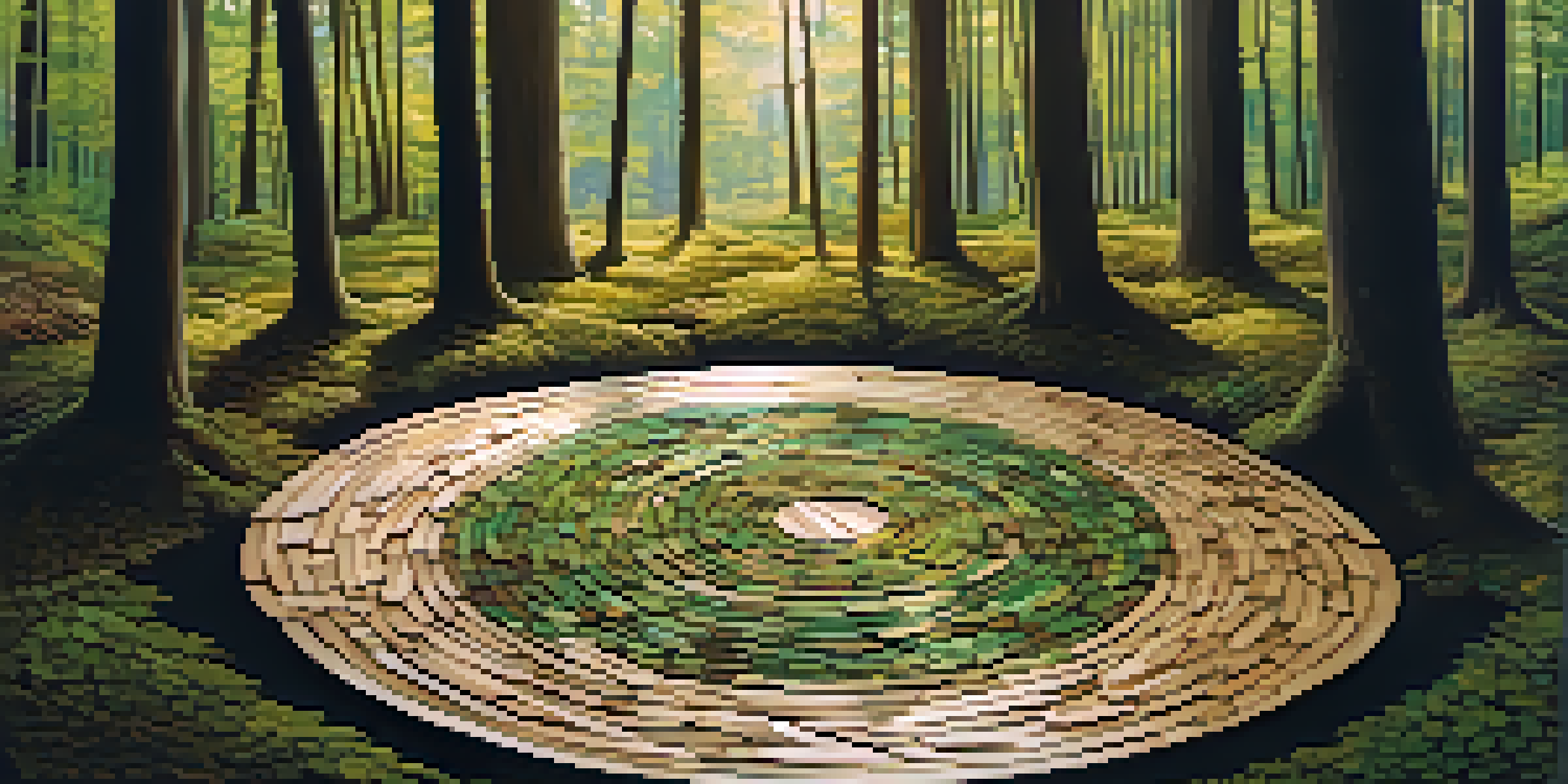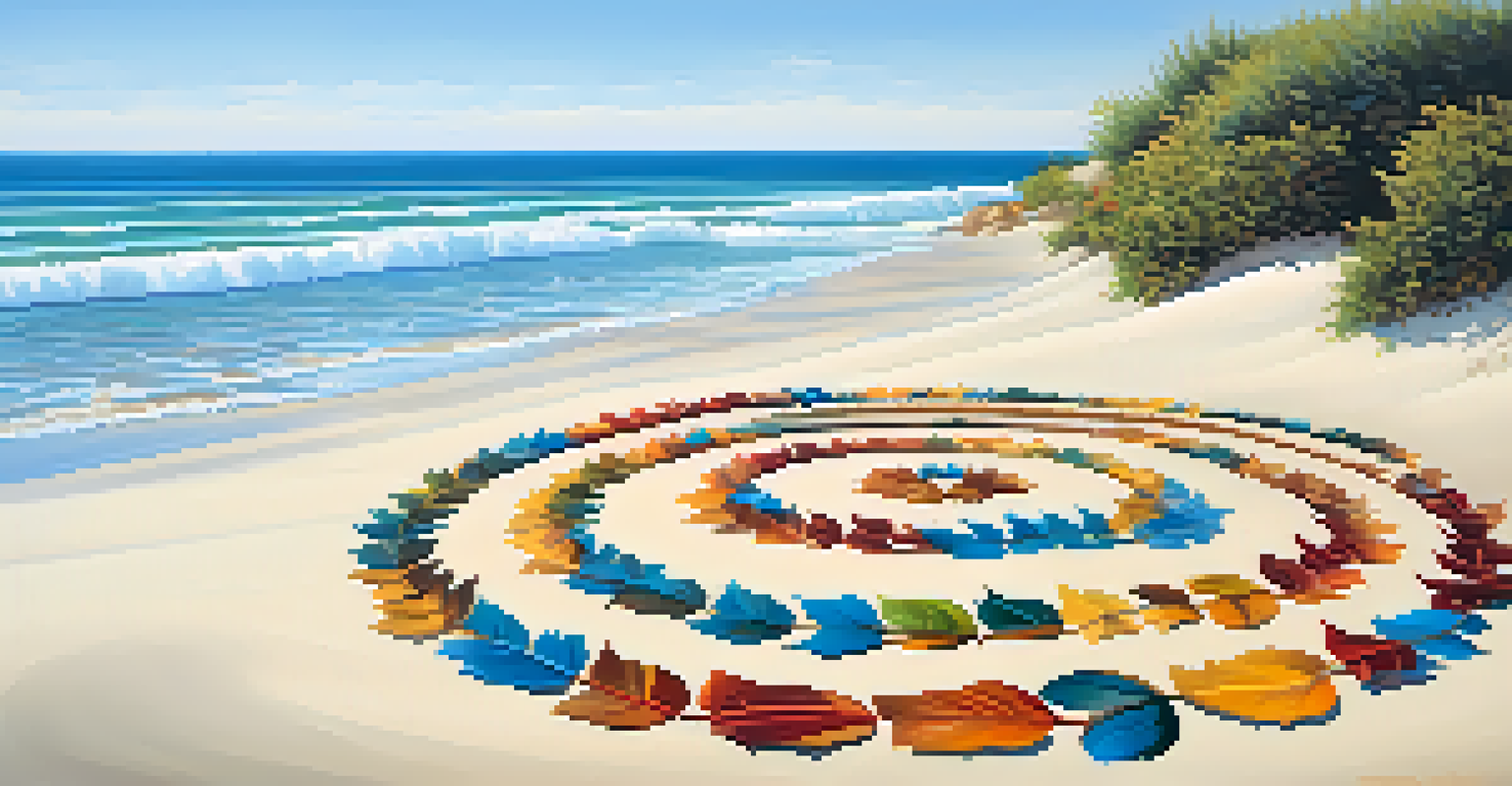Nature's Palette: Using Natural Materials in Environmental Art

Understanding Environmental Art and Its Purpose
Environmental art is a movement that connects art with nature, aiming to raise awareness about environmental issues. It often involves using natural materials and eco-friendly practices to create artworks that reflect the beauty and fragility of our planet. By engaging with nature directly, artists can produce pieces that are not only visually stunning but also provoke thought about conservation and sustainability.
The Earth is art, and we are its canvas.
The goal of environmental art is to inspire viewers to appreciate the natural world and to consider their impact on it. This form of art transcends traditional boundaries, often incorporating elements of land art, installation, and even performance. Artists might use materials like soil, leaves, and stones to create immersive experiences that invite the audience to explore the relationship between humanity and the environment.
Ultimately, environmental art serves as a reminder of our connection to nature and the need to protect it. By incorporating natural materials, artists highlight the beauty that exists in simplicity and encourage us to reflect on our role as stewards of the Earth.
The Benefits of Using Natural Materials in Art
Using natural materials in art brings numerous benefits beyond aesthetic appeal. Firstly, these materials are often more sustainable and environmentally friendly compared to synthetic options. For instance, artists who work with clay, wood, or organic fibers can create pieces that leave a minimal carbon footprint, supporting eco-conscious practices.

Moreover, natural materials can foster a deeper connection between the artist and the environment. When artists gather materials from their surroundings, they engage in a tactile experience that deepens their appreciation for the Earth. This process of sourcing not only inspires creativity but also enhances the artwork's authenticity and story.
Environmental Art Connects Us to Nature
This art movement raises awareness about environmental issues by using natural materials and eco-friendly practices.
Lastly, artworks made from natural materials often evolve over time, adding another layer of meaning. Weathering, decay, and growth can transform these pieces, inviting viewers to contemplate change and the cycle of life. This impermanence encourages a more profound understanding of nature's beauty and resilience.
Examples of Natural Materials in Environmental Art
There are countless examples of artists using natural materials to create impactful environmental art. One notable artist is Andy Goldsworthy, who is renowned for his ephemeral sculptures made from ice, leaves, and stones. His work often blends seamlessly into the landscape, emphasizing the transient beauty of nature and the importance of observing our surroundings.
Art is not a thing; it is a way.
Another inspiring example is the work of Agnes Meyer-Brandis, who creates installations using materials like moss and bark. Her pieces not only celebrate the textures and colors found in nature but also provoke discussions about our relationship with the environment and the ecosystems we inhabit. Such works invite viewers to engage with nature in a more mindful way.
These artists remind us that the Earth itself can be a canvas, and its elements can be transformed into powerful statements about sustainability and connection. By showcasing the versatility of natural materials, they inspire others to explore their creativity while honoring the planet.
Incorporating Natural Materials in Your Own Art
If you're interested in incorporating natural materials into your artwork, start by exploring your local environment. Take walks in parks, forests, or beaches, and observe the textures, colors, and shapes of the materials around you. Gather items like twigs, leaves, stones, or even sand to use in your creations, ensuring you do so sustainably and respectfully.
Next, consider how these materials can enhance your artistic vision. Whether you're painting, sculpting, or creating mixed media pieces, think about the stories these natural elements can tell. For example, using a piece of driftwood in a sculpture can evoke feelings of the ocean and the passage of time, inviting viewers to reflect on their own experiences with nature.
Natural Materials Enhance Creativity
Using natural materials fosters a deeper connection between artists and their environment, inspiring creativity while promoting sustainability.
Lastly, don’t shy away from experimentation. Natural materials can behave differently than traditional art supplies, leading to unexpected results. Embrace the process of discovery, allowing the materials themselves to guide your creativity while celebrating the beauty of the natural world.
The Role of Community in Environmental Art
Community plays a crucial role in the creation and appreciation of environmental art. Collaborative projects often bring together artists, local residents, and environmental groups, fostering a sense of shared purpose and connection. These collaborations not only amplify the impact of the artwork but also strengthen community ties through a collective commitment to environmental stewardship.
For instance, community gardens and public installations can serve as platforms for artists to engage with local residents. By involving the community in the creative process, artists can raise awareness about environmental issues while creating a space for dialogue and education. This inclusive approach encourages participants to take ownership of their environment and inspires action towards sustainability.
Ultimately, community-driven environmental art projects highlight the power of collective action. They remind us that when people come together with a shared vision, they can create meaningful change that resonates far beyond the artwork itself.
Challenges in Working with Natural Materials
While using natural materials in art offers many benefits, it also comes with its own set of challenges. One common issue is the unpredictability of natural elements. Weather conditions, decomposition, and other environmental factors can alter the appearance and integrity of the artwork, making it difficult to maintain and preserve.
Additionally, sourcing materials responsibly is vital to ensuring that the creative process doesn't harm the environment. Artists must be mindful of the impact of their material choices, opting for sustainable or reclaimed sources whenever possible. This consideration can sometimes limit the options available, requiring artists to think creatively about their processes.
Community Collaboration in Art
Community involvement in environmental art projects strengthens connections and promotes shared commitment to sustainability.
Lastly, the ephemeral nature of many natural materials can pose challenges for exhibitions and installations. While this transience can be a beautiful aspect of environmental art, it also raises questions about how to document and share these creations with a wider audience. Artists must navigate the balance between creating temporary experiences and leaving a lasting impact.
The Future of Environmental Art with Natural Materials
As awareness of environmental issues continues to grow, the future of environmental art using natural materials looks promising. Artists are becoming increasingly innovative in their approaches, finding new ways to utilize local materials and engage with pressing ecological challenges. This evolution opens up exciting possibilities for creating impactful works that resonate with audiences.
Moreover, technological advancements are providing artists with tools to document and share their natural art projects more effectively. From virtual reality experiences to social media platforms, artists can now reach broader audiences, amplifying their message about sustainability and environmental awareness. This connectivity can inspire others to explore their own creative expressions within the realm of environmental art.

Ultimately, the future of environmental art lies in its ability to inspire change and foster a deeper connection with nature. As artists continue to push boundaries and challenge perceptions, we can hope to see a growing movement that celebrates and protects our planet through creativity and collaboration.